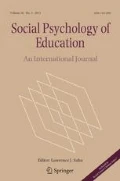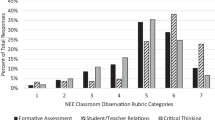Abstract
With the worldwide implementation of students’ evaluation of teaching (SET), faculty attitudes and trust in students’ feedback as well as possible defensive (i.e., self-protective) motivations seem most relevant to the facilitation of the primary organizational goal of SET, namely, teaching improvement. A questionnaire—administered to 2241 faculty members of all ranks in two dozen varied institutions—measured positive attitudes and trust, on the one hand, and beliefs in salient negative faculty SET myths, on the other hand. The most widely-held negative attitudes concerned student fallibilities: vindictiveness; lack of maturity; and negative evaluations of low-achieving students. Despite believing in myths, more than half of the respondents reported trusting SET, thought that it accurately reflected their teaching performance, and considered SET-based feedback useful. A derived index comparing self-evaluations to reported students’ evaluations demonstrated that more than a third of the participants rated their own quality of teaching higher than the ratings they reported typically receiving from their students. This ‘underestimated’ group believed more intensely in SET myths and mistrusted it, which suggests a possible self-protective motivation underlying faculty attitudes. A subgroup of 9% felt strongly underestimated by their students, and a series of comparisons gave clear indications that, for this group of hard-core disgruntled faculty members, the administration of SET questionnaires and the provision of SET feedback are counter-productive. Insights from this research might encourage academic administrations to improve the implementation of SET measurement to increase faculty receptiveness and trust.



Similar content being viewed by others
Notes
The high percentage of agreement with the vindictiveness statement might have been partially influenced by the unfortunate wording of this item: "Students sometimes use evaluations to get back at lecturers". However, personal stories and narratives of close to 1000 instructors (not presented in this paper) revealed that indeed faculty members are extremely concerned about student vindictiveness.
Note that we consider the self- versus student evaluation to be a dynamic personality measure (see discussion related to self-serving biases and teacher self-image in the Introduction section) thus, the reported typical student evaluation is not assumed to be a reliable reflection of actual distributions of student evaluations.
Personal stories and open-ended narratives of close to 1000 of our respondents highlighted an additional salient fault of SET measurement that was not included in our questionnaire. Respondents were extremely concerned about the low rates of students actually filling out the SET surveys, suspecting that student samples are bent and tendentious.
References
Aleamoni, L. (1999). Student rating myths versus research facts from 1924 to 1998. Journal of Personnel Evaluation in Education, 13, 153–166.
Beran, N. B., & Rokosh, J. L. (2009a). Instructors’ perspectives on the utility of student ratings of instruction. Instructional Science, 37, 171–184.
Beran, N. B., & Rokosh, J. L. (2009b). The consequential validity of student ratings: What do instructors really think? The Alberta Journal of Educational Research, 55, 497–511.
Blyth, C. (1972). On Simpson’s paradox and the sure thing principle. Journal of the American Statistical Association, 67, 364–366.
Burden, P. (2010). Creating confusion or creative evaluation? The use of student evaluation of teaching surveys in Japanese tertiary education. Educational Assessment, Evaluation and Accountability, 22, 97–117.
Centra, J. (2003). Will teachers receive higher student evaluations by giving higher grades and less course work? Research in Higher Education, 44, 495–518.
Cohen, P. A. (1990). Bringing research into practice. New directions for teaching and learning, 43, 123–132.
El Hassan, K. (2009). Investigating substantive and consequential validity of student ratings of instruction. Higher Education Research & Development, 28, 319–333.
Emery, C. R., Kramer, T. R., & Tian, R. G. (2003). Return to academic standards: A critique of student evaluations of teaching effectiveness. Quality Assurance in Education, 11, 37–46.
Ericsson, K. A. (2008). Deliberate practice and acquisition of expert performance: A general overview. Academic Emergency Medicine, 15, 988–994.
Feigenbaum, A., & Iqani, M. (2015). Quality after the cuts? Higher education practitioners’ accounts of systemic challenges to teaching quality in times of ‘austerity’. Journal of Further and Higher Education, 39, 46–66.
Harter, S. (1996). Historical roots of contemporary issues involving self-concept. In B. Bracken (Ed.), Handbook of self-concept: Developmental, social and clinical considerations (pp. 1–37). Oxford: Wiley.
Hativa, N. (2013). Student ratings of instruction: recognizing effective teaching. USA: Oron Publications.
Johnson, V. E. (2003). Grade inflation: A crisis in college education. New York: Springer.
L’Hommedieu, R., Menges, R. J., & Brinko, K. T. (1990). Methodological explanations for the modest effects of feedback. Journal of Educational Psychology, 82, 232–241.
Marsh, H. (2007a). Students’ evaluations of university teaching: dimensionality, reliability, validity, potential biases and usefulness. In R. Perry & J. Smart (Eds.), The Scholarship of teaching and learning in higher education: An evidence-based perspective (pp. 319–383). Dordrecht: Springer.
Marsh, H. (2007b). Do university teachers become more effective with experience? A multilevel growth model of students’ evaluations of teaching over 13 years. Journal of Educational Psychology, 99, 775–790.
Marsh, H., & Roche, L. (2000). Effects of grading leniency and low workloads on students’ evaluations of teaching: Popular myth, bias, validity or innocent bystanders? Journal of Educational Psychology, 92, 202–228.
Moore, S., & Kuol, N. (2005). Students evaluating teachers: Exploring the importance of faculty reaction to feedback on teaching. Teaching in Higher Education, 10, 57–73.
Naftulin, D. H., Ware, J. E., & Donnelly, F. A. (1973). The Doctor Fox lecture: A paradigm of educational seduction. Journal of Medical Education, 48, 630–635.
Nasser, F., & Fresco, B. (2002). Faculty views of student evaluation of college teaching. Assessment and Evaluation in Higher Education, 27, 187–198.
Peer, E., & Babad, E. (2014). The Doctor Fox research (1973) re-revisited: “Educational seduction” ruled out. Journal of Educational Psychology, 106, 36–45.
Perry, R. P. (2004). Review of V. Johnson’s grade inflation: A crisis in college education. Academe, January–February, 10–13.
Rosenthal, R., & Rosnow, R. (2009). Artifacts in behavioural research. New York: Oxford University Press.
Schmelkin-Pedhazur, L., Spencer, K. J., & Gellman, E. S. (1997). Faculty perspectives on course and teacher evaluations. Research in Higher Education, 38, 575–592.
Shevlin, M., Banyard, P., Davies, M., & Griffiths, M. (2000). The validity of student evaluation of teaching in higher education: Love me, love my lectures? Assessment & Evaluation in Higher Education, 25, 397–405.
Smith, K., & Welicker-Pollak, M. (2008). What can they say about my Teaching? Teacher educators’ attitudes to standardized student evaluation of teaching. European Journal of Teacher Education, 31, 203–214.
Sproule, R. (2002). The underdetermination of instructor performance by data from the student evaluation of teaching. Economics of Education Review, 21, 287–294.
Stark-Wroblewski, K., Ahlering, R. F., & Brill, F. M. (2007). Toward a more comprehensive approach to evaluating teaching effectiveness: Supplementing student evaluations of teaching with pre–post learning measures. Assessment & Evaluation in Higher Education, 32, 403–415.
Theall, M., & Feldman, K. (2007). Commentary and update on Feldman’s (1997) “Identifying exemplary teachers and teaching: Evidence from student ratings”. In R. Perry & J. Smart (Eds.), The scholarship of teaching and learning in higher education: An evidence-based perspective (pp. 130–143). Dordrecht: Springer.
Wright, S. L., & Jenkins-Guarnieri, M. A. (2012). Student evaluations of teaching: Combining the meta-analyses and demonstrating further evidence for effective use. Assessment and Evaluation in Higher Education, 37, 683–699.
Acknowledgements
The authors wish to thank Efrat Sa’ar, Yehonatan Benayoun and Itamar Shabtai, and the numerous friends and colleagues, Deans and members of the Israeli Forum of Faculty Development Centers in the various colleges and universities, who facilitated the administration of the research in their institutions.
Author information
Authors and Affiliations
Corresponding author
Rights and permissions
About this article
Cite this article
Hammer, R., Peer, E. & Babad, E. Faculty attitudes about student evaluations and their relations to self-image as teacher. Soc Psychol Educ 21, 517–537 (2018). https://doi.org/10.1007/s11218-018-9426-1
Received:
Accepted:
Published:
Issue Date:
DOI: https://doi.org/10.1007/s11218-018-9426-1




